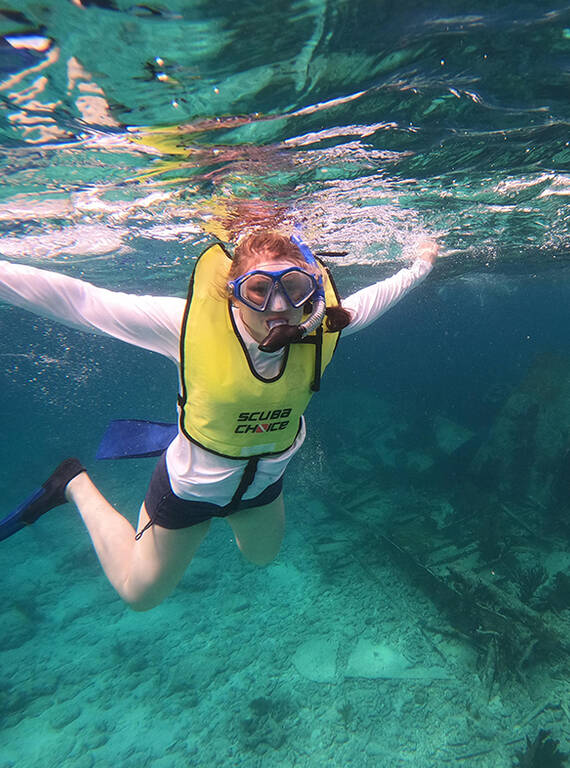Coral reefs help our oceans’ teeming biodiversity survive the impacts of climate change. They also protect communities from severe storms and hurricanes. What happens to corals when 40% of the world’s oceans experience a marine heat wave, as they did this summer?
As a Midwestern transplant to the Sunshine State, there are some things about Florida that will never get old: spotting an alligator along a bike path, witnessing a crocodile in the mangroves, and swimming next to a nurse shark while snorkeling. All are cherished memories. And I’m still keeping my fingers crossed for a chance at that coveted Florida panther sighting.
I have dedicated my career to protecting Florida’s distinctive and fragile environment, and I can attest that the state’s ecosystems and wildlife are truly a wonder.

NPCA staff member Marisa Carrozzo snorkeling in Biscayne National Park.
Image courtesy of Marisa CarrozzoWater underpins this mosaic of habitats and biodiversity, and the turquoise waters surrounding the southern tip of the Florida peninsula do not just inspire postcard vistas – they hide a dynamic underwater ecosystem that stretches 350 miles from Dry Tortugas National Park through the waters of the Florida Keys National Marine Sanctuary, into Biscayne National Park and culminating near the St. Lucie inlet on the East coast.
Known as the Florida Reef Tract, this barrier reef is the third largest in the world and the only one in the continental United States. The tract protects South Florida as its first line of defense during storms and hurricanes.
It also supports coastal marine economies, collectively sustaining 71,000 jobs and generating $6.3 billion in economic benefits from snorkeling, diving, fishing and other marine-related activities, according to the Florida Fish and Wildlife Conservation Commission.
Unfortunately, threats to the reef tract have worsened in recent years. Increased use, marine debris, overfishing, coral disease, pollution, harmful algal blooms and climate change have all accelerated the decline of corals and threatened thousands of species that rely on a healthy reef tract to survive and thrive.
In July and August, a major marine heat wave kickstarted a devastating coral bleaching event, with impacts observed in both Dry Tortugas and Biscayne National Parks, as well as the Florida Keys National Marine Sanctuary. Water temperatures exceeded 90 degrees Fahrenheit. As a result, many corals died or experienced bleaching, but we won’t know the full extent of the damage until late this year or early 2024.
Coral bleaching occurs when water temperatures exceed 88 degrees Fahrenheit for an extended period of time. The symbiotic algae that live in coral, which provide nutrition and color, are expelled by the coral when they become stressed by hot water temperatures. The loss of algae causes the distinctive white “bleached” appearance and means the corals are starving.
If temperatures decrease and conditions stabilize, the algae can repopulate and the coral can recover – which gives us hope for the Florida Reef Tract. However, if the hot temperatures persist long enough, the bleaching can ultimately kill the coral. The stress of marine heat waves and bleaching can also leave corals more susceptible to diseases, intensifying the impacts of the immediate crisis and long-term implications for the ecosystem.
The Intergovernmental Panel on Climate Change expects marine heat waves and increased water temperatures to continue throughout the 21st century. Before the late 1970s and early 1980s, coral bleaching was virtually unheard of globally. According to a graphic published by the Florida Fish and Wildlife Conservation Commission, bleaching events have increased in frequency in Florida over the past 30 years and since 2011 have accelerated to every single year.
We need to do everything possible to ensure the coral reefs across our entire marine park system and connected waters not only survive, but thrive.
NPCA and our partners are working collectively to aid coral reef health. We support the Biden administration’s goals to reduce carbon emissions, we call on Congress to increase funding for parks, and we strongly support creating more national marine sanctuaries, like the one already established in the Florida Keys. Establishing more fully protected marine areas and expanding sanctuary boundaries that safeguard coral reefs and the species that rely on them from the impacts of overuse is especially important.
For example, the National Oceanic and Atmospheric Administration is in the final stages of finalizing a Restoration Blueprint in the Florida Keys that proposes greater protections for coral reefs and “blue carbon” habitats such as seagrasses and mangroves in sensitive areas. This is a critical, long-awaited plan that would make the ecosystem more resilient in the face of rising ocean temperatures.
Here are five facts you may not know about coral reefs and why they need these kinds of protections right away.
1. Coral reefs protect coastal communities
Healthy reefs dissipate 97% of wave energy that would otherwise impact and flood our coastlines. In South Florida, that means protecting over 9 million people. As our corals succumb to climate change impacts like bleaching, we risk losing not only a storm surge buffer, but habitat, shelter and breeding grounds for myriad species of marine life.
2. Reefs support diverse and economically important sea life
Coral reefs harbor some of the highest biodiversity of any ecosystem, providing homes to about 25% of all known marine species. The Florida reef tract alone protects over 6,000 marine species, such as the endangered smalltooth sawfish (an amazing type of ray), sea turtles and ecologically and economically important fish species such as grouper, snapper and hogfish.
3. Reefs are inextricably linked to the visitor experience
Coral reefs exist in 10 national park units — from those in the Atlantic, Gulf of Mexico and Caribbean to the Pacific — and serve as the basis for these park ecosystems and connected waters. For example, Biscayne National Park is 95% water and attracts over 700,000 visitors a year who come from around the world to dive, snorkel, fish, paddle and enjoy wildlife at the largest marine park in the National Park System.
Without healthy coral reefs, the park cannot provide the same one-of-a-kind experience for swimmers, divers and explorers from all walks of life. The health of the reef tract within Biscayne is inextricably linked with visitor experience, healthy fish populations and coastal resilience, which is why NPCA has been advocating for the establishment of a no-fishing marine reserve in the park. Such a reserve would relieve pressure on an already stressed coral reef.
4. Place-based resilience strategies work
Fully protected marine areas, like the one NPCA is fighting for in Biscayne National Park, are an essential tool for agencies along the Florida Reef Tract as we implement place-based strategies to build the ecosystems’ resilience to the serious impacts of climate change.
Five years after a fully protected marine area in Dry Tortugas National Park was established in 2007, studies showed significant increases in the size and abundance of once over-fished species. No-fishing marine reserves such as this one mean healthier fish populations throughout the reef, and they provide relief for sensitive coral areas from the impacts of anchoring and overuse.
5. The Inflation Reduction Act will help save coral reefs
In August, the White House announced its first set of Inflation Reduction Act projects directed toward climate change and its effects on national parks. A total of $203,000 was allocated to implement coral reef stewardship in six parks in Florida and the U.S. Virgin Islands, including Biscayne National Park.
Addressing climate change must be coupled with strong protections for our remaining reef ecosystems and the necessary funding to restore and recover from ongoing bleaching events and other stressors, such as disease. And while this investment will aid coral recovery efforts, more federal funding is needed not only to restore coral populations, but to ensure they can survive hotter climate patterns for years to come.
Racing against the clock to save our corals
This summer, federal and local agencies, academic researchers and coral reef restoration groups raced against the clock to save what coral they could by moving them to nurseries in cooler water or on-land holding facilities. They also are studying the responses of different genetic strains of coral to thermal stress. But their work is predicated on the assumption that our local, national and global actions will begin to seriously curtail and mitigate the impacts of rampant carbon dioxide emissions.
This summer’s marine heat wave and record high water temperatures are a stark reminder that addressing climate change is the urgent call to action of our time.
Stay On Top of News
Our email newsletter shares the latest on parks.
We face a paradox: We need coral reefs and their teeming biodiversity to help oceans survive the impacts of climate change and protect communities from increasingly severe storms and hurricanes. At the same time, the warming oceans are decimating these foundational ecosystems. We need to do everything possible to ensure the coral reefs in Dry Tortugas, Biscayne and across our entire marine park system and connected waters not only survive, but thrive. If we succeed, these amazing places can continue protecting our earth as we explore, enjoy and make new memories for generations to come.
About the author
-
 Marisa Carrozzo Senior Coastal & Wildlife Program Manager, Sun Coast
Marisa Carrozzo Senior Coastal & Wildlife Program Manager, Sun CoastMarisa Carrozzo is Senior Coastal & Wildlife Program Manager with NPCA’s Sun Coast Region. As an environmental policy professional with a proven track record in leadership and coalition-building across diverse stakeholder groups, Marisa works collaboratively to protect and enhance the treasured coastal and wildlife resources within and linked to the 21 national park units within the Sun Coast.
-
General
-
- NPCA Region:
- Sun Coast
-
Issues


